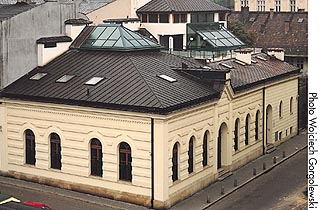|

Judaica Foundation and its Center for Jewish Culture in
Krakow
From the 16th century on the
Jewish quarter at Kazimierz
– once a separate city in its own right, now a district
of downtown Krakow – was the capital of Poland’s Jews
and one of the main centers of Diaspora in Europe. After
World War II its Jewish traditions seemed to belong to the
past until they have been revived by the Judaica Foundation
since 1991. In 1993 it set up the Center for Jewish
Culture (Centrum Kultury Zydowskiej in Polish) in
Krakow’s Kazimierz
neighborhood.
Krakow's hub of Jewish culture.
Both the Judaica Foundation and the Jewish Cultural Center
have their seats in a corner building at 17 Rabbi Meisels
street and Plac Nowy square, now thoroughly refurbished,
which once served as the B’nai Emuna prayer house in
the 19th-century. Their motto is “L’dor v’dor” (“from
generation to generation” in Hebrew) and they protect
Poland’s Jewish heritage, popularize it, and conduct
research.
Activities of the Jewish Cultural Center in Krakow.
Every year numerous shows, recitals, conferences and other
cultural and scholarly activities take place in the Jewish
Cultural Center at 17 Meiselsa street. It's also a popular
venue for concerts of classical music.
The flagship program of the Judaica Foundation is called
Bayit Khaddash
–
Month of Encounters with Jewish Culture. Bayit Khaddash
translates as 'New Home' and the program consists in
series of events – from lectures to concerts to various
shows – taking place in the Jewish Cultural Center almost
every day from late September through November. They have
been organized yearly since 1996 and every of the events may
feature either Jewish or Polish cultural and historical
traditions but preferably both.
Contact information of the Center of Jewish Culture
Postal address: Centrum Kultury
Zydowskiej, ul. Meiselsa 17, 31-058 Krakow, Poland. Phone
(+48) 124306449. Fax (+48) 124306497. Email info@judaica.pl
Web site www.judaica.pl
Other hot spots in Krakow
Grand Square
Krakow’s central Grand Square (Rynek Glowny), the
largest plaza of medieval Europe and one of the world’s finest
with its spectacular landmarks, has remained the hub of the city
since the 13th century.
Thanks to its maximum
seating capacity of 18,000 or so, the Krakow Arena easily surpasses in size any other indoor
stadium in Poland
and ranks among Europe’s largest venues of this type. It also beats other domes
on such counts as novelty or versatility.
ICE stands for International Conferencing and Entertainment. Its main Auditorium Hall can
seat 2,000 people. The seating capacity of two other,
smaller halls is 600 (Theater) and 300 (Chamber Hall)
respectively. Plus there is so called Conference Hall
Complex of 11 rooms seating 35 people each.
Schindler
Factory
Famous wartime sweatshop has been turned into an
ingenious museum of the harsh realities in Krakow under the
Nazi occupation.
Palace of Arts
Temple of Fine Arts from the turn of the 20th century.
Bunker of Arts
Bulwark of the newest art.
Manggha
Japan Culture and Technology Center
Fine example of the world's newest architecture is the
scene of numerous cultural events, and most have something to do
with Japan.
International Culture Center
Exhibitions, conferences, and much more.
Villa Decius
Almost perfect Renaissance Italian villa shelters
Krakow's European Academy.
|
